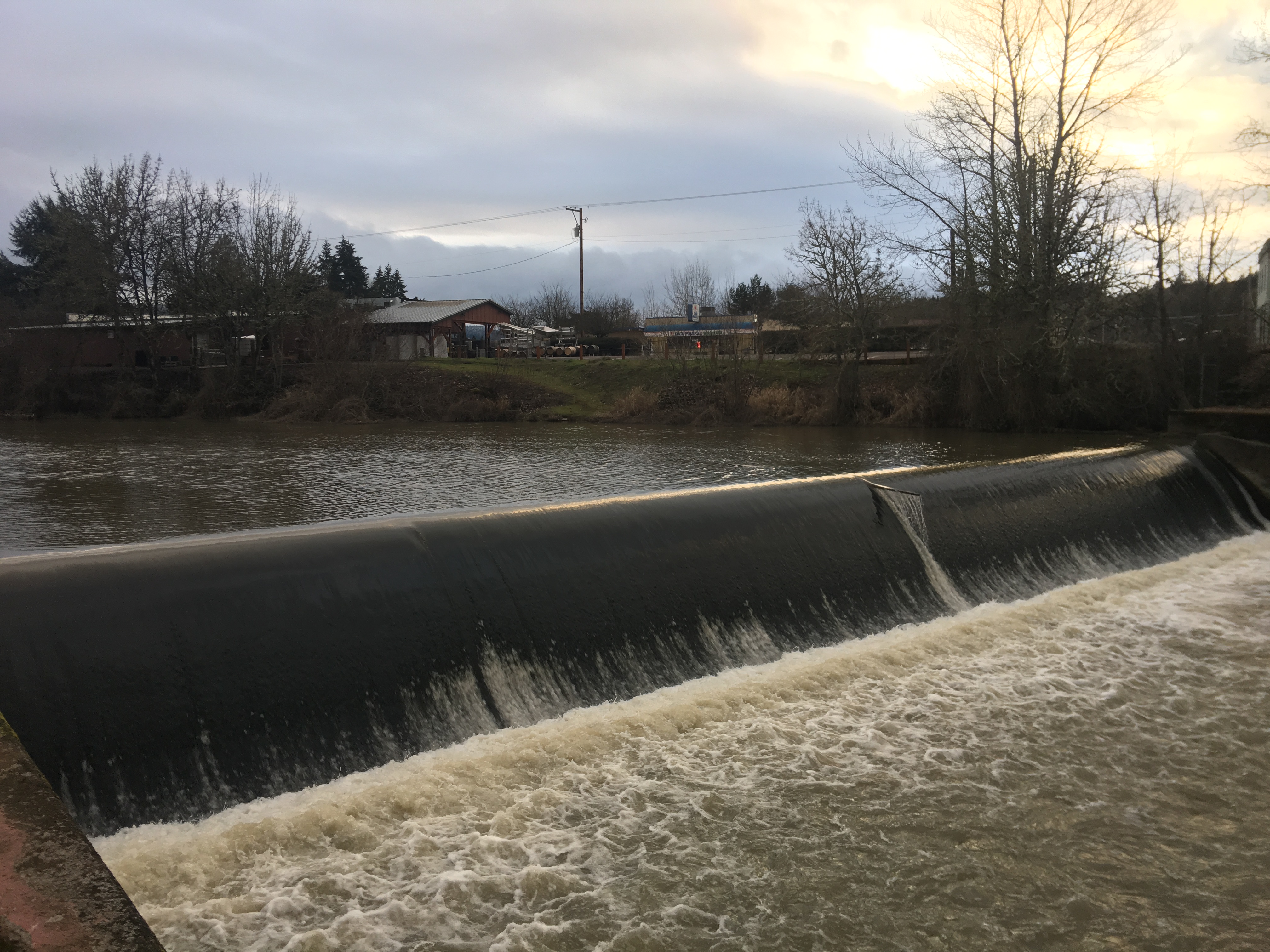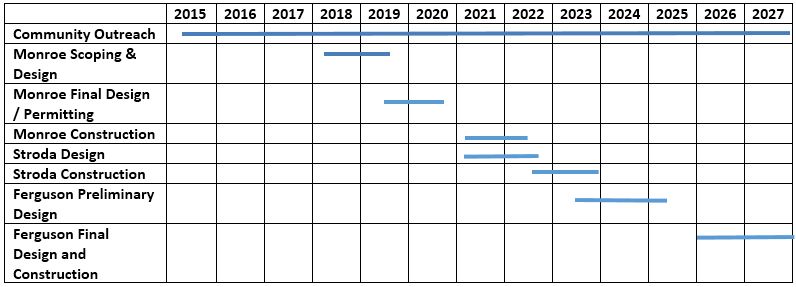Project Overview
The Long Tom River rises in the Central Oregon Coast Range and flows east to join the Willamette River. In 1941, the U.S. Army Corps of Engineers built a flood control and water supply dam called Fern Ridge in the upper watershed, several miles west of Eugene. The maximum discharge from the reservoir exceeded the capacity of the meandering, low-gradient Long Tom River downstream. To reduce erosion from reservoir discharges, starting in 1943 the Corps straightened the Long Tom River, removed woody debris, built levees, and armored the channel. This work converted a 36-mile reach of the river into a straighter, deeper, and rock-lined stretch of 23 miles. The Corps also built three low-head dams between 7.5 feet and 11.5 feet high in order to slow the river’s velocity and reduce scour. The lowest such structure is at the small town of Monroe.
At 85 feet wide and about 9.5 feet high, the Monroe drop structure completely spans the river. It was built at the site of a former mill race. The mill race fish ladder is passable only by adult fish (primarily cutthroat trout) at certain water levels. Fish passage at the Stroda drop structure several miles upstream is impeded, but the owner of adjacent land has agreed to cooperate in installing effective passage if passage is first improved at Monroe. Nearly three miles farther upstream, the Ferguson drop structure allows adult and possibly juvenile passage through a side channel, but this arrangement likely could be improved. Modification, Bypass or Removal of the Monroe drop structure will restore passage to over 3.5 miles of main stem river habitat. When passage at the upstream Stroda and Ferguson structures are addressed, juvenile fish will have access to 106 miles of additional main stem and tributary habitat.
The Monroe drop structure completely blocks juvenile salmon, including federally threatened upper Willamette spring-run chinook salmon, which rear in the Long Tom River after hatching in the McKenzie and Middle Fork Willamette rivers. Juvenile upper Willamette River spring-run chinook salmon have been collected below the Monroe drop structure. The presence of juvenile spring-run in other west-side tributaries nearly 30 miles from the Willamette River suggests that given access, these fish would likely rear in Long Tom tributaries far upstream of Monroe.
The Monroe drop structure also stymies passage of anadromous Pacific lamprey. After the structure was built, local residents reported huge numbers of lamprey (“eels”) and fluvial cutthroat trout stacked against its base. The Long Tom River also harbors native redside shiners, dace, sculpin and stickleback.
Salmon restoration in Oregon’s Willamette River Valley requires a comprehensive, systematic approach. The degradation of functional conditions from a habitat perspective involves 150 years of dam-building (13 large dams and more than 400 small), the straightening and armoring of rivers, clearing of bottomland forest, and draining of wetlands. Both salmon spawning and rearing habitat would need to be restored. The Long Tom River watershed is a priority because of its high-quality fish rearing habitat, and the Monroe drop structure is the lowest barrier to that habitat. Watershed assessments done in 2000, 2005 and 2009 called for addressing fish barriers on the Long Tom.
Project Slideshow & Site Photos
60 Riverside Landowners Engaged
12 Public Meetings, Tours & Events
$200,000 Grant Dollars brought to the project
Project Milestones & Progress
In 2015, with a grant from the Oregon Watershed Enhancement Board, the Long Tom Watershed Council investigated fish passage restoration. The Corps proposes to analyze flood issues on the river with hydrologic modeling and expects to consider alternative ways to modify its system on the Long Tom to allow fish passage. For the Corps to begin analysis, it needs to have internal authorization for a “new start” under WRDA 1986 Section 1135, which provides authorization for the Corps to modify existing projects to improve the environment. This project is rated within the Portland District as the highest priority within the District for an 1135 new start, due to the community support and the fishery impacts.
Community support for fish passage at the Monroe drop structure is broad and includes many local leaders. Alternatives have been defined and drawn at a conceptual level, and analysis is needed to determine resulting water levels related to city water intake, ODOT bridge footings upstream, water levels in the adjacent park and wetlands during the year, and for people to understand how the river will look and sound under different scenarios and seasons. Many local landowners have a stake in the waterfront, which makes early and thorough outreach imperative. The watershed council has a new state grant for stakeholder engagement that will increase the knowledge and experience of Monroe citizens with the river. Water supply and flooding issues must be addressed. Monroe draws its water supply from the impounded reach, so removal is contingent on finding a way to continue to divert water. Neither the Corps nor the community will support dam removal if it exacerbates flooding.
Estimated Project Timeline
Fish passage at Monroe has been a vision for the council since it’s inception over 21 years ago. Our 21 years of work upstream benefits numerous species of native fish and wildlife, and is an essential foundation for the work now underway in Monroe.
This timeline picks up in 2015 with the beginning of our in-earnest outreach in Monroe. It includes phases II and III for the remaining drop structures between Monroe and Fern Ridge.
Current Phase
This year, the Army Corps of Engineers is engaged in an ‘1135 Authority’ process to determine the federal interest in the project, and review proposed fish passage alternatives. Local partners, which include the Watershed Council and City of Monroe, will help guide the process, reflect local priorities, and leverage the significant modeling work and technical assistance already completed or underway. We will continue to engage with local stakeholders and ensure that fish passage, along side other watershed health and community values are represented in the process.
Project Benefits
- Restore access for juvenile salmon and cutthroat trout to 3.5 miles of main stem habitat.
- Restore access to 106 miles of main stem and tributary habitat once all three drop structures have been removed or modified to allow fish passage.
- Improve access for federally threatened spring-run chinook salmon and two species of lamprey, and improve conditions for cutthroat, Oregon chub, redside shiners, dace, sculpin, stickleback, western pond turtles, and red-legged frogs.
- Eliminate the safety and liability hazard from the low-head dam in the town of Monroe.
- Enhance the aesthetic appeal and recreation potential of the Monroe waterfront business area.
Plans & Reports
Coming Soon…
How Can I Help?
Visit the page for our current fundraising campaign for this project HERE, and give generously today to help this vision for a better connected lower Long Tom river, become a reality.
Have technical expertise and time to give? Fill out our Volunteer Interest Form!
FAQ
Q: What is the function and purpose of the dam in Monroe now? Does it store water?
A: The dam in Monroe is considered a “run of river” dam, which mean there is no water storage function for the dam. As water enters the ponded area behind the dam from upstream, it exits over the dam at the same rate and has no effect on flows downstream. The primary function of the dam is to dissipate energy of the river as it falls over the dam. This dissipation was designed to extend the lifespan and reduce maintenance of the channelized and constructed segments of the river downstream. The Army Corps 1135 process underway will explore the continued utility of the structure in supporting the Corps mission on the Long Tom, and determine what effects, if any, various fish passage alternatives would have upon the constructed channel. A secondary function of the dam is to provide predictable pool depth for the City of Monroe’s drinking water intake. Any proposed alternatives for the dam will include alternatives for securing Monroe’s access to drinking water in the Long Tom. [for more information about the Watershed Council’s work in partnership with the City of Monroe to improve the City’s drinking water: Click here]
Q: Why does the watershed council need my support to address a federally owned structure?
A: This is a watershed wide vision that is bigger than just the dam in Monroe. The Monroe fish passage barrier is the first that migrating fish encounter on their way upstream from the Willamette, and the most complex to find a solution for. The Watershed Council has stewarded this project for the last 4 years, and has leveraged resources for technical review of the project, inundation modeling, community outreach efforts, visioning with Monroe decision makers, and continued dialogue with a steering committee of local stakeholders, and even an opportunity for local school children in Monroe to interact with the native fish below the dam. The Army Corps’ 1135 process requires continued engagement from local partners, including the Watershed Council to help guide the project locally, leverage local resources, and continue to reflect back the priorities of the watershed into the federal process. Once the 1135 process is complete, the Watershed Council and the City of Monroe will continue to be local partners responsible for continuing the stewardship of the project before and after construction. Our ability to stay engaged is essential for a successful project to secure fish passage at Monroe!
Q: When do you expect successful fish passage to be achieved at this site?
A: That largely depends upon the alternatives selected. For some alternatives, we may see full fish passage as soon as 2021. Others requiring more complex engineering solutions may not see completion until 2022-23 or later.
Q: What about the other structures upstream of Monroe? Are they also fish barriers? Are you going to remove Fern Ridge Dam?
A: Upstream of Monroe there are three additional fish passage barriers. Two of those barriers are passable at some high-flow conditions. One has a design solution that can be implemented in future phases of habitat enhancement in the lower Long Tom river mainstem. The other is also included as a priority in our Lower Long Tom River Habitat Enhancement Plan and potential exists to address fish passage at both structures. The dam in Monroe is the first and highest priority to address for passage as its the first barrier that migrating fish encounter when moving upstream from the Willamette. The Fern Ridge dam is a community resource with multiple values for recreation, irrigation flow management, and flood risk mitigation. While Fern Ridge is a fish barrier at all flows, there is over 100 miles of habitat for native fish available on the Long Tom mainstem and Coast Range tributaries between the Monroe dam, and Fern Ridge dam that is currently inaccessible to migrating fish. Our priority is to reconnect those 100 miles of habitat in the Lower Long Tom (below Fern Ridge Dam), and its tributaries to the main stem of the Willamette River and to restore function of this highly managed and modified section of river. Fish passage at Fern Ridge is not a current priority for the council.




